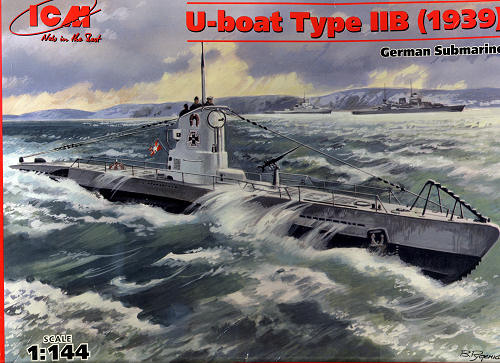
ICM 1/144 Type IIb U-boat (1939)
| KIT #: | S009 |
| PRICE: | $32.95 MSRP |
| DECALS: | None |
| REVIEWER: | Scott Van Aken |
| NOTES: |

| HISTORY |
The Type II U-boat was designed by Germany as a coastal U-boat, modeled after the CV-707 submarine, which was designed by the Dutch dummy company NV Ingenieurskantoor voor Scheepsbouw den Haag (I.v.S) (set up by Germany after World War I in order to maintain and develop German submarine technology and to circumvent the limitations set by the Treaty of Versailles) and built in 1933 by the Finnish Crichton-Vulcan shipyard in Turku, Finland. It was too small to undertake sustained operations far away from the home support facilities. Its primary role was found to be in the training schools, preparing new German naval officers for command. It appeared in four sub-types.
The defining characteristic of the Type II was its tiny size. Known as the Einbaum ("dugout canoe"), it had the advantages over larger boats of the ability to work in shallow water, diving more quickly, and being more difficult to spot due to the low conning tower. However, it had a shallower maximum depth, short range, and cramped living conditions, and could carry few torpedoes.
The boat had a single hull, with no watertight compartments. There were three torpedo tubes forward (none aft), with space for another two torpedoes inside the pressure hull for reloads. A single 20 mm anti-aircraft gun was provided, but no deck gun was mounted.
Space inside was limited. The two spare torpedoes extended from just behind the torpedo tubes to just in front of the control room, and most of the 24-man crew lived in this forward area around the torpedoes, sharing 12 bunks. Four bunks were also provided aft of the engines for the engine room crew. Cooking and sanitary facilities were basic, and in this environment long patrols were very arduous.
Most Type IIs only saw operational service during the early years of the war, thereafter remaining in training bases. Six were stripped down to just a hull, transported by river and truck to Linz (on the Danube), and reassembled for use in the Black Sea against the Soviet Union.
In contrast to other German submarine types, few Type IIs were lost. This, of course, reflects their use as training boats, although accidents accounted for several vessels.
These boats were a first step towards re-armament, intended to provide Germany with experience in submarine construction and operation and lay the foundation for larger boats to build upon. Only one of these submarines survives to this day; the prototype CV-707, renamed Vesikko by the Finnish Navy which later bought it.
On February 3, 2008, The Telegraph reported that U-20 had been discovered by Selšuk Kolay, a Turkish marine engineer in 80 feet (24 m) of water off the coast of the Turkish city of Zonguldak. The paper also reported that Kolay knows where U-23 and U-19 are, scuttled in deeper water near U-20.
| THE KIT |
 ICM adds to their growing submarine collection with this very nicely done type IIb submarie. As is typical with most submarines, the parts count is relatively low. It consists of two separate hull halves, a very small sprue for two conning towers, and a larger sprue for the rest of the boat.
ICM adds to their growing submarine collection with this very nicely done type IIb submarie. As is typical with most submarines, the parts count is relatively low. It consists of two separate hull halves, a very small sprue for two conning towers, and a larger sprue for the rest of the boat.
The kit includes a display stand. The upper deck is a separate piece and the full hull has a pair of bulkheads to glue in place to add strength. Most of the parts are for the various fittings on the conning tower and for the deck gun, with some of them being quite finely molded. This includes various hand holds and the railing around the deck gun. There are optional bits. The two conning towers are pretty much identical except that one has steps built into the rear section. There are also two different styles of plinth on which the deck gun fits.
Instructions are on two sheets of folded paper. One has the seven instruction steps. The drawings are well done, but it seems that they have been resized down to fit the sheet. The result is that the small print is somewhat difficult to read, especially for those with older eyes. The color information is by Model Master paints. There are two submarines that can be built from this kit; U9 from May 1940 and U19 from March of that same year. There are no decals so apparently these boats were devoid of any markings. There are subtle differences between these two boats in that U19 has the more conical gun mount and the DF antenna mounted inside the conning tower. There is no indication as to which of these boats, if either, has the conning tower with the steps in the rear. You have to look at the color guide to tell what differences there are as they are not pointed out in the construction portion of the instructions.
| CONCLUSIONS |
Despite the missing guidance on the correct fit of each boat, it is a kit that is well molded, relatively free of defects (I found a sink area or two on some of the thicker parts), and should provide no real challenges in construction. ICM has come a long way during its history and their newer kits are really worth the effort of seeking out.
| REFERENCES |
October 2010 Thanks to Squadron Products for the preview kit. Get yours today at your local shop or on-line retailer. If you would like your product reviewed fairly and fairly quickly, please contact the editor or see other details in the Note to Contributors.